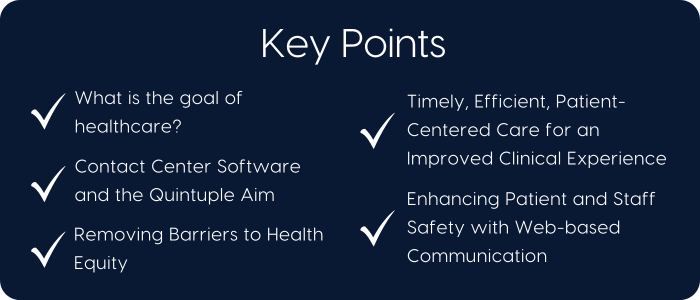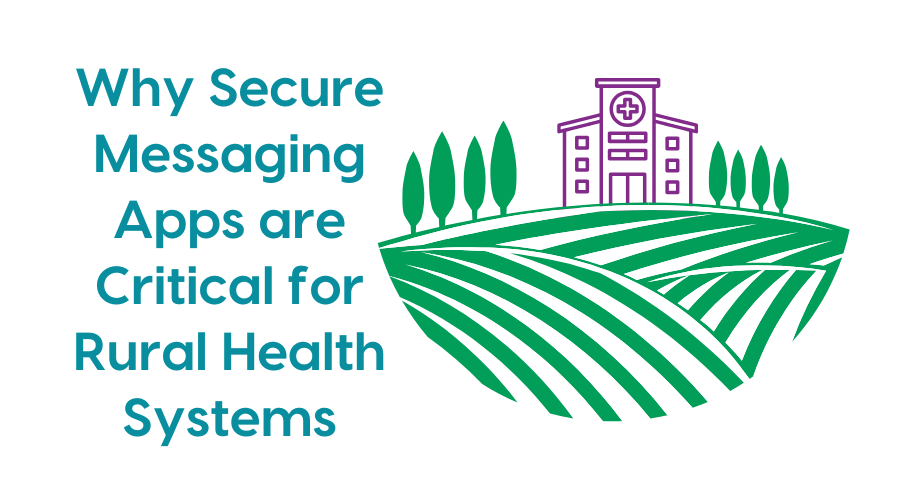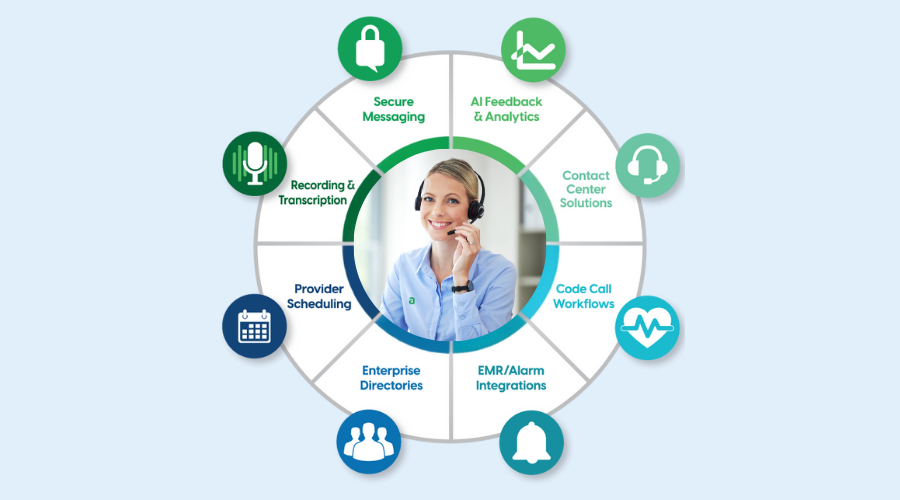What is the goal of healthcare? An answer such as “good health” may seem like an obvious response, however, sometimes a simple question has a complex answer. For many years, one of the most influential answers to this question was put forth in 2001 by the Institute of Medicine (IOM) in a report called “Crossing the Quality Chasm.” Their framework included these six goals for any healthcare system:
- Safe: Avoiding harm to patients from the care that is intended to help them.
- Effective: Providing services based on scientific knowledge to all who could benefit and refraining from providing services to those not likely to benefit (avoiding under-use and misuse).
- Patient-centered: Providing care that is respectful of and responsive to individual patient preferences, needs, and values and ensuring that patient values guide all clinical decisions.
- Timely: Reducing waits and sometimes harmful delays for both those who receive and those who give care.
- Efficient: Avoiding waste, including waste of equipment, supplies, ideas, and energy.
- Equitable: Providing care that does not vary in quality because of personal characteristics such as gender, ethnicity, geographic location, and socioeconomic status.

In 2006, two faculty members of the Institute for Healthcare Improvement (IHI), John Whittington, MD and Tom Nolan, MD, came up with the idea of the “Triple Aim” to define the aims of healthcare. They concluded the social needs outlined by the IOM were only for individuals who needed care. The health of the population was a second component that wasn’t included in the IOM framework.
The Triple Aim is made up of three points:
- Experience of Care: The original IOM list (above).
- Population Health: Addresses the “why” related to healthcare needs. “Why does a person have a heart attack, break their arm, or experience depression?” This point looks at the causes of why a person experiences an adverse health event, and how to keep each individual in good health.
- Per Capita Cost: Keep costs down because most individuals, companies, and governments have limited resources and need to spend funds on things other than healthcare.
Additional aspects to the Triple Aim have been adopted by healthcare organizations to include Improved Clinical Experience (the Quadruple Aim) to combat staff burnout and lower patient satisfaction and Health Equity (the Quintuple Aim) as it pertains to policy including systematic incorporation, measurable and transparent reporting, consideration of systemic contributing factors, and reimbursement.
Contact Center Software and the Quintuple Aim
Most of the previously-mentioned goals include a communication component. Effective communication software that works with an organization’s existing technology is an important tool to help healthcare systems achieve the Quintuple Aim.
Removing Barriers to Health Equity
The Health Resources and Services Administration (HRSA) is a federal agency of the U.S. Department of Health and Human Services and is focused on improving the healthcare of people who are considered to be geographically isolated, and economically or medically vulnerable. Medically under-served populations and areas are designated by HRSA as having too few primary care providers, high infant mortality, high poverty, or a high elderly population.
These populations include uninsured individuals, vulnerable populations including the elderly, low-income, ethnic minorities, migrants, and people who received a limited education, and those with poor access to healthcare because of inadequate transportation or a lack of available services.
Technology enables medical contact centers to effectively become an extension of a hospital or clinic’s operations 24 hours a day, 7 days a week. Robust communication software used by hospital centers can securely access a patient’s electronic medical record (EMR), update EMRs with notes, and record calls that need to be used for insurance claims and workman’s compensation. Because everything is documented, detailed reports can be generated for reporting purposes.
Hospital contact centers help to address two of the biggest barriers to healthcare – language and transportation. Medical staff work with an enormously diverse patient population. Understanding a person’s language leads to better healthcare. Multi-lingual contact center operators or confidential over-the-phone interpreting (OPI) services can be used for access to hundreds of different languages.
Patients with mobility challenges or who live in rural areas can receive some health services via telehealth. Operators can coordinate care, make follow-up calls, schedule visits, contact on-call medical staff, and manage referrals. Contact centers that are staffed by qualified nurses or multidisciplinary teams (such as a resident, pharmacist, and social worker) can make health assessments, give medical advice, mental health counseling, and escalate critical concerns.

Timely, Efficient, Patient-Centered Care for an Improved Clinical Experience
Getting the right message, to the right person, at the right time can improve patient care. The need for efficient, reliable communication is present throughout a patient’s journey. A hospital’s contact center is the hub of communication for an organization’s calls and chats and the same software that is used at the center can also be leveraged within the hospital or clinic to improve clinical communication and workflows.
When a patient is admitted into a hospital, they may be moved from one room to another while waiting for tests and procedures, and during recovery. It can become difficult to locate and communicate with a patient once they are receiving care within the system.
A robust contact center platform can assign a fixed phone number to each patient to follow the patient for the duration of their stay. Associating each patient with one phone number helps ease the stress of family and friends who are trying to contact them, streamline the communication process for anyone on the patient’s care team, and reduce the number of calls to the hospital’s contact center.
Contact center software can work together with a hospital’s event notification software system to expedite enterprise-wide critical alerts in healthcare environments by capturing requests from ADT (Admission, Discharge, and Transfer) messages, nurse call messages, smart beds, pain management, alerts, alarms, orders, or appointments. Then, emergency notification software instantly sends those messages to designated medical staff recipients using a wide variety of methods, including Vocera badges, IP phones from Cisco and Spectralink, SMS, e-mail, secure messaging apps, and more. All statistics can also be accumulated for each notification to provide an easy-to-follow audit trail for reporting purposes and to help healthcare organizations refine their communication processes.
Enhancing Patient and Staff Safety with Web-based Communication
The ability to access health information at any time from virtually any place is a fundamental and critical part of any healthcare organization’s communication protocol. Hospital personnel can use some of the same web-based communication software that is used in their call center to deliver fast, secure, communications.
- Secure Messaging: Secure organizational communication is crucial for protecting patients, medical staff, and hospital organizations. HIPAA-compliant messaging apps send secure text, photo, audio, and video content while protecting patient privacy. These apps can be used via smartphones, tablets, and desktop computers. Secure messaging apps can be leveraged to simplify collaborative care to provide a better patient experience, and speed the process of patient admissions, lab results, patient transport, and more. An additional benefit of secure messaging is the ability to triage low-priority alerts and route alarms directly to clinician devices to reduce sensory overload for both patients and care providers. Patient care is improved when important alarms get a response as quickly as possible, but a restful, quiet healing environment is also important for patient recovery.
- Care Team Collaboration: Mobile-friendly care team collaboration applications are used by nurses, physicians, and other staff to remotely access on-call schedules, directories, messages, reports, and more.
- Workforce Management: Staff can view, edit, copy, override, assign, and unassign schedules in real-time. They can use directories to quickly find and contact staff and use the reporting function to track, view, and print communications.
Correcting inefficient communication can help an organization towards their Triple, Quadruple, or even Quintuple Aim. Using the tools and software that may already be available in a hospital’s contact center provides a path to successfully attain the goals of the entire enterprise.





